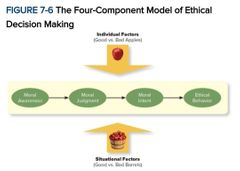![]()
![]()
![]()
Use LEFT and RIGHT arrow keys to navigate between flashcards;
Use UP and DOWN arrow keys to flip the card;
H to show hint;
A reads text to speech;
53 Cards in this Set
- Front
- Back
- 3rd side (hint)
|
What are the origins of organizational behavior? |
Has roots in psychology, sociology, and anthropology. |
|
|
|
Define organizational behavior |
Field of study devoted to understanding, explaining, and ultimately improving the attitudes and behaviors of individuals and groups in organizations. |
Definition. |
|
|
Describe why human capitals can create a competitive advantage? |
Good people are... Rare Inimitable Valuable |
RIV |
|
|
Human capital... |
Create socially complex resources, make numerous small decisions, and create a history. |
List three things |
|
|
Identify the individual mechanisms that influence the two primary OB outcomes. |
Job satisfaction Stress Motivation Trust Justice Ethics |
List 6 factors. |
|
|
Identify the factors that influence the two primary OB outcomes. |
Organizational Mechanisms Group mechanisms Individual Characteristics |
List three things |
|
|
What is job performance? |
task performance citizenship behavior counterproductive behavior |
List 3 things. |
|
|
What is task performance? |
Employee behaviors that are directly involved in the transformation of organizational resources into the goods and services that the organization produces. |
Definition. |
|
|
What is citizenship behavior? |
Voluntary employee activities that may or may not be rewarded, but contribute to the organization by improving the overall quality of the setting or context in which work takes place. |
Definition. |
|
|
What is counterproductive behavior? |
Intentional employee behaviors that hinder organizational goal accomplishment. |
|
|
|
What are the three types of organizational commitment? |
Affective commitment Continuance commitment Normative commitment |
List 3 things. |
|
|
Describe affective commitment. |
You stay because you want to (emotional attachment) |
Definition. |
|
|
Describe continuance commitment. |
You stay because you need to (too risky or expensive to leave) |
Definition. |
|
|
Describe normative commitment. |
You stay because you ought to (feeling of debt / obligation) |
Definition. |
|
|
Define job satisfaction. |
How you feel about your job and what you think about your job. |
Definition. |
|
|
Identify job satisfaction by facets. |
Pay satisfaction Promotion satisfaction Supervision satisfaction Coworker satisfaction Satisfaction with the work itself. |
5 facets listed. |
|
|
Identify the consequences of job satisfaction. |
Job performance and organizational commitment |
Two things. |
|
|
Identify job characteristics that create a sense of satisfaction with the work itself |
Variety Identity Significance Autonomy Feedback |
Visit Island Sofia And Fish |
|
|
How does job satisfaction affect job performance? |
Satisfied employees do a better job of fulfilling work duties, and can pull attention away from distractions and back to work. |
|
|
|
How does job satisfaction affect organizational commitment? |
Satisfied employees are more likely to want to stay with the organization. |
|
|
|
How does job satisfaction affect life satisfaction? |
People feel better about thier lives when they feel better about their jobs. |
|
|
|
Define personality. |
What people are like. |
|
|
|
Explain the factors that determine an individual’s personality |
The structures and propensities inside people that explain thier characteristic patterns of thought, emotion, and behaviors. |
|
|
|
Identify the key traits in the Big Five personality model. |
Consciousness Agreeableness Neuroticism Openness Extraverison |
Canoe |
|
|
Demonstrate how the Big Five traits predict behavior at work. |
Most important trait for work = conscientiousnes 2nd Most important trait for work = neuroticism |
|
|
|
What is the definition of motivation? |
A set of energetic forces that originates both within and outside an employee, initiates work related effort, and determines its direction, intensity, and persistence. |
Definition. |
|
|
Describe Expectancy Theory |

Expectancy (more effort = better Performance?) Instrumentality (better Performance = outcomes) Valence (satisfying outcomes?) |
EPO Picture |
|
|
What may shape a person’s self-efficacy and how will self-efficacy affect the person’s motivation? |
Past accomplishments - if they've succeeded or failed in the past. Vicarious experience - observations / discussions with people who have done the task. Verbal persuasion - others persuade them to get the job done. Emotional cues - feelings can create doubt or boost confidence. |
List 4 things and explain |
|
|
What is the difference between extrinsic and intrinsic motivation? |
Extrinsic - motivation controlled by some contingency that depends on task performance. intrinsic - motivation felt when task performance is the reward. |
Define both. |
|
|
What is goal setting theory? |
Views goals as the primary driver of the intensity and persistence of effort. |
Definition. |
|
|
What qualities make goals strong predictors of task performance? Why? |
Specific and Difficult goals. Gives people a measuring stick for how hard / long they should be working. |
Don't forget the why! |
|
|
Describe equity theory. |
Suggests that employees create a mental ledger of the outcomes they receive for thier job inputs relative to thier job duties. |
Definition. |
|
|
What does it mean to be equitably treated? |
The ratio of outcomes to inputs is balanced between you and your comparison other. |
|
|
|
How do employees respond when they feel a sense of inequity? |
Any imbalance in the ratio creates equity distress, an internal tension that can only be alleviated by restoring balance to the ratios. |
|
|
|
Describe psychological empowerment. |
An energy rooted in the belief that tasks are contributing to some larger purpose. |
|
|
|
What beliefs determine how empowered employees feel? |
Meaningfulness Impact Self-determination Competence |
MISC |
|
|
What is the definition of trust? |
The willingness to be vulnerable to a trustee based on positive expectations about the trustee's actions and intentions. |
Definition. |
|
|
Describe the three types of trust |
Disposition-based trust: personality (think predisposed, genetic) Cognition-based trust: rooted in rational assessment. Affect-based trust: based on feeling. (Blind trust) |
Describe not list. |
|
|
What is the definition of trust propensity? |
A general expectation that the words, promises, and statements of individuals and groups can be relied upon. |
|
|
|
What shapes trust propensity? |
Genetics and life experiences |
|
|
|
Describe the dimensions of trustworthiness. |
Ability- skills / competence/ expertise Benevolence- belief that authority wants to do good for the trustor Integrity- belief that authority adheres to an acceptable set of values |
|
|
|
What is the definition of justice? |
The perceived fairness of an authority's decision making. |
|
|
|
Describe the four dimensions of justice. |
Distributive justice: perceived fairness of outcomes. Procedural justice: perceived fairness of decision making process. Interpersonal justice: perceived fairness of employee treatment by authorities. Informational justice: perceived fairness of communication provided to employees from authorities. |
|
|
|
Procedure justice Vs. distributive justice (outcomes) |
Without procedure justice there cannot be distributive justice. They influence each other. |
|
|
|
What is the definition of ethics? |
The degree to which behaviors of an authority are in accordance with generally accepted moral norms. |
|
|
|
What is the four component model of ethical decision making. |

|
Pic M(aji)EB |
|
|
What is moral awareness? |
When an authority recognizes that a moral issue exists in a situation. |
Definition. |
|
|
Describe the dimensions of ethical intensity. |
Moral intensity is high when: - there is a high potential for harm. - there is social pressure surrounding an act. |
|
|
|
What is moral judgment? |
When an authority can accurately identify the "right" course of action. |
Definition. |
|
|
Describe the theory of cognitive moral development. |
As people age and mature they move through several states of moral development, each more mature than the prior one. |
Definition. |
|
|
Describe the principles for moral judgment. |
Consequentialist principles - judges morality based on outcome. Nonconsequentialist principles - judges morality based on its intrinsic desirability. |
2 principles |
|
|
What is moral intent? |
An authority's degree of commitment to the moral course of action. |
Definition. |
|
|
What is the role moral identity plays in morality and behavior? |
People with strong moral identities volunteer and donate to charities more. |
Charity example. |

